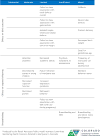Marijuana Use in Pregnancy and While Breastfeeding
- PMID: 30234728
- PMCID: PMC6370295
- DOI: 10.1097/AOG.0000000000002878
Marijuana Use in Pregnancy and While Breastfeeding
Abstract
The prevalence and perceived safety of marijuana use in pregnancy are increasing with expanding legalization. Marijuana crosses the placenta and passes into breast milk, resulting in fetal and neonatal exposure. Many women cite medical reasons for prenatal marijuana use such as nausea and vomiting of pregnancy, anxiety, and chronic pain. The scientific literature regarding marijuana in pregnancy is mixed, resulting in confusion among practitioners as to how to counsel women about risks of use. In addition, there is a paucity of literature related to marijuana use and breastfeeding. Existing pregnancy studies are predominantly retrospective cohorts with a reliance on self-report for ascertainment of exposure, which underestimates use. Many studies fail to adjust for important confounding factors such as tobacco use and sociodemographic differences. Despite the limitations of the existing evidence, there are animal and human data suggesting potential harm of cannabis use. The harms are biologically plausible given the role of the endocannabinoid system in pregnancy implantation, placentation, and fetal neurologic development. Two recent systematic reviews and meta-analyses found an association between marijuana use and adverse perinatal outcomes, especially with heavy marijuana use. In addition, three longitudinal cohort studies demonstrate a possible effect of prenatal marijuana exposure on long-term neurobehavioral outcomes. Marijuana use may be associated with growth restriction, stillbirth, spontaneous preterm birth, and neonatal intensive care unit admission. Therefore, women should be advised to refrain from using marijuana during pregnancy and lactation.
Conflict of interest statement
Dr. Metz did not report any potential conflicts of interest.
Figures





References
-
- Metz TD, Stickrath EH. Marijuana Use in Pregnancy and Lactation: A Review of the Evidence. Am J Obstet Gynecol. 2015;213(6):761–78. - PubMed
-
- Retail Marijuana Public Health Advisory Committee. Monitoring Health Concerns Related to Marijuana in Colorado: 2016. Changes in Marijuana Use Patterns, Systematic Literature Review, and Possible Marijuana-Related Health Effects. Colorado Department of Public Health and Environment; 2016. https://drive.google.com/file/d/0B0tmPQ67k3NVQlFnY3VzZGVmdFk/view.
-
- Marijuana use during pregnancy and lactation. Committee Opinion No. 722. American College of Obstetricians and Gynecologists. Obstet Gynecol. 2017;130:e205–e9. - PubMed
-
- Conner SN, Bedell V, Lipsey K, Macones GA, Cahill AG, Tuuli MG. Maternal Marijuana Use and Adverse Neonatal Outcomes: A Systematic Review and Meta-analysis. Obstet Gynecol. 2016;128:713–23. - PubMed
Publication types
MeSH terms
Substances
Grants and funding
LinkOut - more resources
Full Text Sources
Other Literature Sources
Medical

